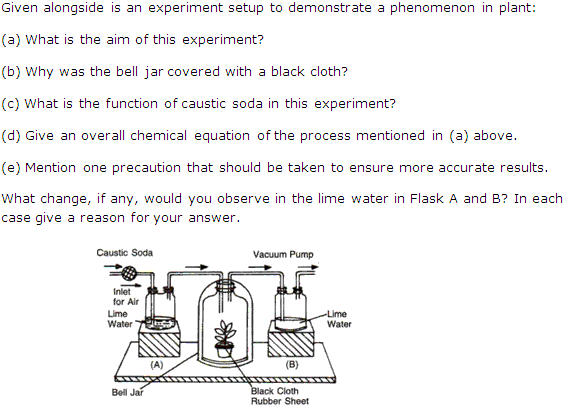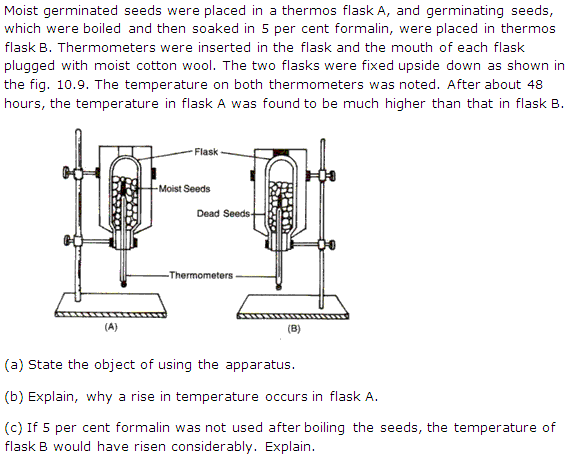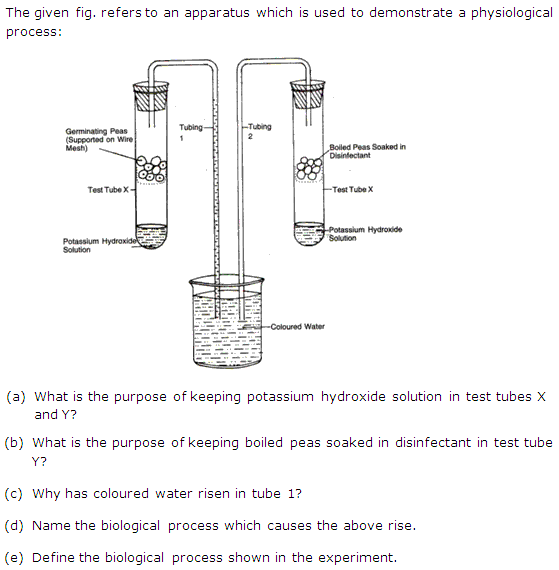Chapter 10 - Respiration in Plants Exercise 87
Question 1
Answer the following:
(a) What do you understand by respiration?
(b) What are the respiratory substrates? Give two examples.
(c) Write the overall equation of aerobic respiration.
(d) What is alcoholic fermentation?
(e) Which process is common to aerobic and anaerobic respiration?
(f) Where does glycolysis take place in the living cell?
(g) Name the cell organelle in which Kreb's take place.
(a) What do you understand by respiration?
(b) What are the respiratory substrates? Give two examples.
(c) Write the overall equation of aerobic respiration.
(d) What is alcoholic fermentation?
(e) Which process is common to aerobic and anaerobic respiration?
(f) Where does glycolysis take place in the living cell?
(g) Name the cell organelle in which Kreb's take place.
Solution 1

Question 2
Distinguish between:
(a) Fermentation and anaerobic respiration.
(b) Aerobic respiration and anaerobic respiration.
(c) Respiration and combustion.
(a) Fermentation and anaerobic respiration.
(b) Aerobic respiration and anaerobic respiration.
(c) Respiration and combustion.
Solution 2

Question 3
How will you demonstrate that energy is released during aerobic and anaerobic respiration?
Solution 3

Question 4
Do you agree that respiration is the reverse of photosynthesis?
Solution 4
Yes, respiration is the reverse of photosynthesis.
Question 5

Solution 5
(i) - (b) nutrients are oxidized without using molecular oxygen by the process of fermentation.
(ii) - (c) is the best organic substrate for respiration.
(iii) - (a) partial breakdown of food substance.
(iv) - (e) the series of change from glucose to pyruvic acid in respiration.
(v) - (d) the intermediate substance in the breakdown of glucose.
(ii) - (c) is the best organic substrate for respiration.
(iii) - (a) partial breakdown of food substance.
(iv) - (e) the series of change from glucose to pyruvic acid in respiration.
(v) - (d) the intermediate substance in the breakdown of glucose.
Chapter 10 - Respiration in Plants Exercise 88
Question 1

Solution 1

Question 2
Fill in the blanks:
(a) Fermentation is a type of ______ respiration.
(b) The first phase of respiration is ______.
(c) ______ is the last product of glycolysis.
(d) The final hydrogen acceptor in aerobic respiration is ______.
(e) In living cells glycolysis occurs in ______.
(a) Fermentation is a type of ______ respiration.
(b) The first phase of respiration is ______.
(c) ______ is the last product of glycolysis.
(d) The final hydrogen acceptor in aerobic respiration is ______.
(e) In living cells glycolysis occurs in ______.
Solution 2
(a) Anaerobic
(b) Glycolysis
(c) Pyruvic acid
(d) Oxygen
(e) Cytoplasm
(b) Glycolysis
(c) Pyruvic acid
(d) Oxygen
(e) Cytoplasm
Question 3
Write True or False against each of the following statements:
(a) Combustion is a biological process.
(b) Kreb's cycle is common to both types of respiration.
(c) Glycolysis takes place in the crystal of the mitochondria.
(d) Protein is the first choice as a respiratory substrate.
(e) The respiration is faster than combustion.
(a) Combustion is a biological process.
(b) Kreb's cycle is common to both types of respiration.
(c) Glycolysis takes place in the crystal of the mitochondria.
(d) Protein is the first choice as a respiratory substrate.
(e) The respiration is faster than combustion.
Solution 3
(a) False
(b) False
(c) False
(d) False
(e) False
(b) False
(c) False
(d) False
(e) False
Question 4

Solution 4
(a) To show that heat is evolved during respiration
(b) In flask A, moist seeds respire and produce heat that increases the temperature.
(c) If formalin was not used, bacteria will grow on the dry seeds and respire anaerobically to produce a little heat.
(b) In flask A, moist seeds respire and produce heat that increases the temperature.
(c) If formalin was not used, bacteria will grow on the dry seeds and respire anaerobically to produce a little heat.
Chapter 10 - Respiration in Plants Exercise 89
Question 1
Complete the following statement by selecting the correct alternative from the ones given within brackets: The immediate source of energy for metabolic reactions in a living cell is ______.
(glucose ATP, protein)
(glucose ATP, protein)
Solution 1
glucose ATP
Question 2
(a) Give the overall chemical equation that represents anaerobic respiration in plants.
(b) Mention any three points in which respiration is exactly opposite of photosynthesis.
(b) Mention any three points in which respiration is exactly opposite of photosynthesis.
Solution 2

Question 3

Solution 3
(a) To absorb carbon dioxide produced during respiration
(b) If these are not soaked in disinfectant, the bacterial growth may be there in the tube Y and accurate result may not be obtained due to bacterial respiration.
(c) The germinating peas respire and oxygen is used which create a vacuum in the tube. So coloured water has risen in tube1.
(d) Respiration
(e) It is defined as the stepwise oxidation of glucose in the living cells to release energy.
(b) If these are not soaked in disinfectant, the bacterial growth may be there in the tube Y and accurate result may not be obtained due to bacterial respiration.
(c) The germinating peas respire and oxygen is used which create a vacuum in the tube. So coloured water has risen in tube1.
(d) Respiration
(e) It is defined as the stepwise oxidation of glucose in the living cells to release energy.
Question 4
Write scientific terms for the following:
(a) The power house of the cell.
(b) Anaerobic respiration in the muscles.
(a) The power house of the cell.
(b) Anaerobic respiration in the muscles.
Solution 4
(a) mitochondria
(b) Fermentation
(b) Fermentation
Question 5
Differentiate between glycolysis and Kreb's cycle (reaction site of the process in a cell).
Solution 5

Question 6
Differentiate between aerobic and anaerobic respiration (end-products of the process)
Solution 6

Question 7
Complete the following statements by choosing the correct alternative out of those given within brackets.
(a) Every living cell of the plant (respire / photosynthesizes / as well as photosynthesizes).
(b) Normally, respiration takes place in (day / night / day and night).
(c) Carbon dioxide and water are formed in (photosynthesis / aerobic respiration / anaerobic respiration).
(d) In respiration, temperature (rises / comes down / remains the same).
(e) In respiration, energy is released in (controlled manner / uncontrolled manner / the form of light).
(a) Every living cell of the plant (respire / photosynthesizes / as well as photosynthesizes).
(b) Normally, respiration takes place in (day / night / day and night).
(c) Carbon dioxide and water are formed in (photosynthesis / aerobic respiration / anaerobic respiration).
(d) In respiration, temperature (rises / comes down / remains the same).
(e) In respiration, energy is released in (controlled manner / uncontrolled manner / the form of light).
Solution 7
(a) Respires
(b) Day and night
(c) Aerobic respiration
(d) Rises
(e) Controlled manner
(b) Day and night
(c) Aerobic respiration
(d) Rises
(e) Controlled manner
Chapter 10 - Respiration in Plants Exercise 90
Question 1
Name the following:
(a) The process of living beings which is concerned with the release of energy for use in the body.
(b) The energy currency of the body.
(c) The respiration that takes place in the presence of oxygen.
(d) The respiration takes place in the absence of oxygen.
(e) The chemicals generally used to absorb carbon dioxide in respiratory experiments.
(f) The solution that turns milky when carbon dioxide is passed through that solution.
(g) The products formed as a result of aerobic respiration.
(h) The products formed as a result of anaerobic respiration.
(a) The process of living beings which is concerned with the release of energy for use in the body.
(b) The energy currency of the body.
(c) The respiration that takes place in the presence of oxygen.
(d) The respiration takes place in the absence of oxygen.
(e) The chemicals generally used to absorb carbon dioxide in respiratory experiments.
(f) The solution that turns milky when carbon dioxide is passed through that solution.
(g) The products formed as a result of aerobic respiration.
(h) The products formed as a result of anaerobic respiration.
Solution 1
(a) Respiration
(b) ATP
(c) Aerobic respiration
(d) Anaerobic respiration
(e) Caustic potash and KOH
(f) Lime water
(g) Carbon dioxide and water
(h) Ethyl alcohol and carbon dioxide
(b) ATP
(c) Aerobic respiration
(d) Anaerobic respiration
(e) Caustic potash and KOH
(f) Lime water
(g) Carbon dioxide and water
(h) Ethyl alcohol and carbon dioxide
Question 2
Every question has four options. Choose the correct answer:
(i) In the process of respiration
(a) ADP is converted to ATP.
(b) Glucose is converted to carbon dioxide.
(c) Glucose is converted to carbon dioxide and water, releasing energy.
(d) Pyruvic acid is converted to ATP.
(ii) Which order is right for cellular respiration from the following
(a) Electron transfer, glycolysis, Kreb's cycle.
(b) Kreb's cycle, electron transfer, glycolysis.
(c) Electron transfer, Kreb's cycle, glycolysis.
(d) Glycolysis, Kreb's cycle, electron transfer.
(iii) Less energy is liberated in anaerobic respiration in yeast in comparison with aerobic respiration because
(a) Energy is not formed by oxygen.
(b) Less CO2 is formed.
(c) Energy is left in alcohol.
(d) Yeast requires less energy.
(iv) The role of oxygen in cellular respiration
(a) To form CO2
(b) To liberate energy from hydrogen storage.
(c) To change pyruvate into acetyl CoA.
(d) To accept hydrogen and form water.
(v) The materials formed in anaerobic respiration are
(a) CO2 and water
(b) CO2 and alcohol
(c) CO2 and formaldehyde
(d) CO2 and haemoglobin
(vi) The reactions of Kerb's cycle occurs in
(a) Lysosomes
(b) grana
(c) Mitochondria
(d) endoplasmic reticulum
(vii) Who discovered the Kreb's cycle?
(a) Kolliker
(b) Hens Krebs
(c) Altman
(d) Benda
(viii) Alcohol is produced during the process of
(a) photosynthesis
(b) aerobic respiration
(c) combustion
(d) fermentation
(ix) The energy liberated during respiration is stored in the form of
(a) heat
(b) ATP
(c) ADP
(d) NADP
(x) Mitochondria is the storage house for:
(a) NADH
(b) Pyruvic acid
(c) ATP
(d) Citric acid
(xi) How many ATP molecules are gained in glycolysis?
(a) Zero
(b) Two
(c) Four
(d) Eight
(xii) Where does the glycolysis take place?
(a) In cytoplasm
(b) In chloroplast
(c) In ribosome
(d) In mitochondria
(xiii) The energy liberated in aerobic respiration is
(a) 637 Kcal
(b) 600 Kcal
(c) 673 Kcal
(d) 693 Kcal
(i) In the process of respiration
(a) ADP is converted to ATP.
(b) Glucose is converted to carbon dioxide.
(c) Glucose is converted to carbon dioxide and water, releasing energy.
(d) Pyruvic acid is converted to ATP.
(ii) Which order is right for cellular respiration from the following
(a) Electron transfer, glycolysis, Kreb's cycle.
(b) Kreb's cycle, electron transfer, glycolysis.
(c) Electron transfer, Kreb's cycle, glycolysis.
(d) Glycolysis, Kreb's cycle, electron transfer.
(iii) Less energy is liberated in anaerobic respiration in yeast in comparison with aerobic respiration because
(a) Energy is not formed by oxygen.
(b) Less CO2 is formed.
(c) Energy is left in alcohol.
(d) Yeast requires less energy.
(iv) The role of oxygen in cellular respiration
(a) To form CO2
(b) To liberate energy from hydrogen storage.
(c) To change pyruvate into acetyl CoA.
(d) To accept hydrogen and form water.
(v) The materials formed in anaerobic respiration are
(a) CO2 and water
(b) CO2 and alcohol
(c) CO2 and formaldehyde
(d) CO2 and haemoglobin
(vi) The reactions of Kerb's cycle occurs in
(a) Lysosomes
(b) grana
(c) Mitochondria
(d) endoplasmic reticulum
(vii) Who discovered the Kreb's cycle?
(a) Kolliker
(b) Hens Krebs
(c) Altman
(d) Benda
(viii) Alcohol is produced during the process of
(a) photosynthesis
(b) aerobic respiration
(c) combustion
(d) fermentation
(ix) The energy liberated during respiration is stored in the form of
(a) heat
(b) ATP
(c) ADP
(d) NADP
(x) Mitochondria is the storage house for:
(a) NADH
(b) Pyruvic acid
(c) ATP
(d) Citric acid
(xi) How many ATP molecules are gained in glycolysis?
(a) Zero
(b) Two
(c) Four
(d) Eight
(xii) Where does the glycolysis take place?
(a) In cytoplasm
(b) In chloroplast
(c) In ribosome
(d) In mitochondria
(xiii) The energy liberated in aerobic respiration is
(a) 637 Kcal
(b) 600 Kcal
(c) 673 Kcal
(d) 693 Kcal
Solution 2
(i) (c) Glucose is converted to carbon dioxide and water, releasing energy.
(ii) (d) Glycolysis, Kreb's cycle, electron transfer
(iii) (c) Energy is left in alcohol.
(iv) (d) To accept hydrogen and form water.
(v) (b) CO2 and alcohol
(vi) (c) mitochondria
(vii) (b) Hens Krebs
(viii) (d) fermentation
(ix) (b) ATP
(x) (c) ATP
(xi) (b) Two
(xii) (a) In cytoplasm
(xiii) (c) 673 Kcal
(ii) (d) Glycolysis, Kreb's cycle, electron transfer
(iii) (c) Energy is left in alcohol.
(iv) (d) To accept hydrogen and form water.
(v) (b) CO2 and alcohol
(vi) (c) mitochondria
(vii) (b) Hens Krebs
(viii) (d) fermentation
(ix) (b) ATP
(x) (c) ATP
(xi) (b) Two
(xii) (a) In cytoplasm
(xiii) (c) 673 Kcal

0 comments:
Post a Comment